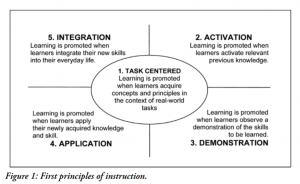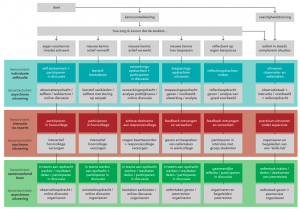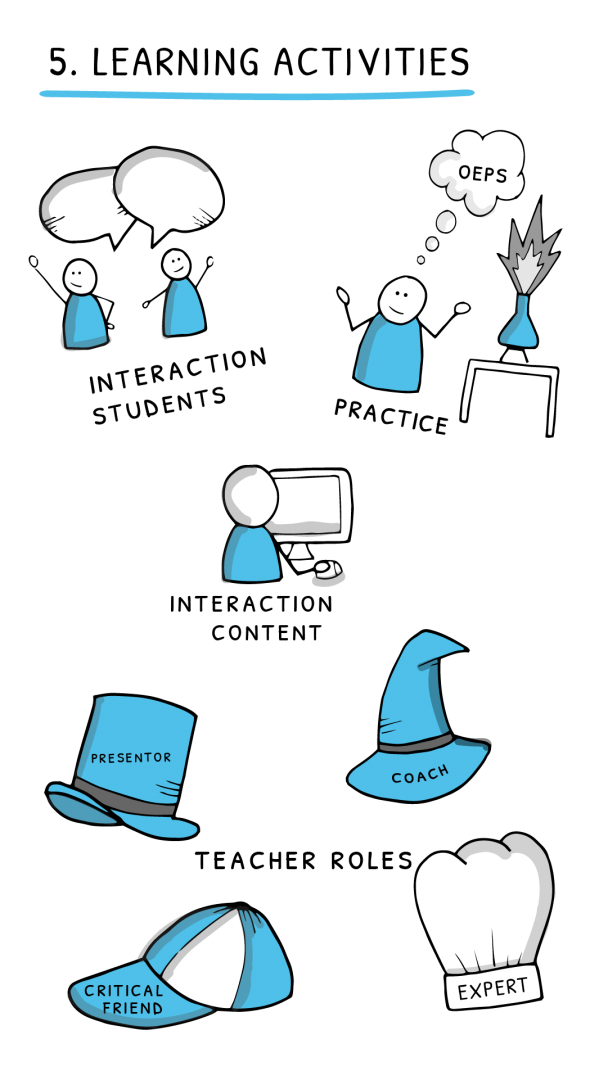Developing learning activities
‘Learning is a verb’, so what are students meant to do? This is the question to ask when developing learning activities. Which activities help students achieve the intended learning outcomes and objectives? What is the lecturer’s role in this? How do you get students to take ownership? Where is cooperation needed? And how do the learning activities prepare the students for tests?
Why?
In developing learning activities, you are designing the education you impart. They bring together the various elements of the curricular spiderweb. Students’ learning activities provide experiences, feedback and knowledge that can help them achieve the desired learning outcomes, which they can demonstrate by way of professional products and/or testing.
Wat?
Learning activities comprise all activities students carry out to achieve their learning objectives and outcomes. Using a variety of online and offline learning activities (differentiation) gives your students more freedom and a greater say in content, time, format and place, in order for the activities to match their personal talents and ambitions.
All learning activities taken together could be seen as the journey of students towards the learning outcomes. This travel metaphor can help ensure a clear coherence between learning activities. The journey taken by students can be described as follows:
1. From initial level to learning outcomes, or vice versa
This is where the elements of the curricular spiderweb (NL) come together.
- In the analysis and the design, you have described the initial level and the learning outcomes. Use these as the point of departure and destination of the journey.
- Divide the journey into logical intermediate steps, taking into account the learning outcomes (learning content; cognitive, social or practical skills; affective goals) and the number of ECTS credits for the course (1 credit = 28-hour study load).
Also, include milestones in the journey: at various points, students practise the material and discover through feedback and feed forward to what extent they have achieved the learning outcomes (feed up).
To find out more about feedback, see this article by Hattie and Timperley (2007).
2. The journey in detail
A. For the several stages, determine:
- Which sources and materials go with this learning content or with these skills, and what type of activities is used to process this theory? (cognitive presence)
- Are these activities carried out individually or in a group? (social presence)
- How much supervision do the students need? Based on the characteristics of the target group and the complexity of the learning content or learning activity (assignments).
- How do the activities contribute to students’ motivation? Do the activities stimulate autonomy, competence and connectedness (see also self-determination theory)?
- Do students have enough opportunities to practise the learning outcomes, and how do they receive feedback?
- Which activities are well suited to being done online or asynchronously? When is there added value to carrying out the activities synchronously, in a physical setting? (article: blended learning wave).
B. Elaborate the stages per week or per theme:
-
- Decide on the order of the learning contents and the development skills.
- Gradually increase the difficulty level of the activities, keeping the available time in mind.
- Plan learning activities in such a way that all phases of a complete learning process are followed.
- activating prior knowledge;
- adding new information/acquiring knowledge and skills;
- processing information/knowledge;
- applying acquired knowledge and skills;
- reflecting on the learning process.
- For this, use the First principles of instruction
 Source: https://link.springer.com/article/10.1007/BF02505024
Source: https://link.springer.com/article/10.1007/BF02505024 - Offer enough opportunities for interaction among students through feedback or formative evaluation.
- Decide for each learning activity whether it will be carried out online or offline. On FBE’s Edulab website (NL)

3. Role of the lecturer
Are you a travel guide who accompanies the journey, or will you only equip your students with a map, a compass and an end goal? The lecturer’s role (NL) may be different for different learning activities, such as:
- The lecturer
You use varied teaching methodologies to impart knowledge to your students and to stimulate them to develop knowledge themselves. You help students develop expertise.
- The coach or trainer
You help students work in teams or on projects. You coach them in developing the skills needed for this. Think of task distribution, pointing things out to each other and providing feedback in the project group. You help students develop professional skills.
- The student career adviser
You teach students to plan and guide their academic and professional careers themselves. What do they want to achieve? To what extent are they achieving this, and what else is needed? In this role, you will have a lot of personal contact with students: you are their first point of contact, you help them make decisions and you monitor their academic progress. You also guide students in their personal development.
- The researcher
You use your own research as a source for new knowledge for students, and you use research results to create course material. You supervise students as they do research and develop research skills in the graduation phase.
4. Final check before setting off
Once you have developed the learning activities, you have the foundation for your module. This is a good time to pause and review what you have done so far.
To what extent do the learning activities offer students:
- the right study load, both during the module as a whole and in each teaching week;
- enough interaction with fellow students;
- enough interaction with the selected sources and materials;
- enough feedback on their progress from lecturers and fellow students;
- adequate preparation for tests;
- appropriate and sufficient exercises to achieve the learning outcomes?
And to what extent do the learning activities offer lecturers:
- clarity about the use of sources and materials;
- clarity about how the learning activities contribute to achieving the learning outcomes;
- the ability to express their role(s) adequately;
- enough tools for supervising student development;
insight into students’ progress?
How?
There are various models and methods for developing learning activities, such as:
A specific model or method may already have been chosen based on the degree programme’s vision on teaching and learning.

